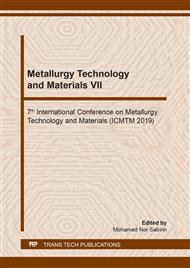[1]
C.A. Gould, N.Y.A. Shammas, S. Grainger, and I. Taylor. Thermoelectric cooling of microelectronic circuits and waste heat electrical power generation in a desktop personal computer. Materials Science and Engineering: B. 176(4), (2011), 316-325.
DOI: 10.1016/j.mseb.2010.09.010
Google Scholar
[2]
T.M. Tritt. Thermoelectric Phenomena, Materials, and Applications. Annual Review of Materials Research. 41(1), (2011), 433-448.
DOI: 10.1146/annurev-matsci-062910-100453
Google Scholar
[3]
D.M. Rowe. CRC handbook of thermoelectrics. CRC Press. (1995).
Google Scholar
[4]
S.H. Bae, S.Y. Lee, H.Y. Kim, and S. Im. Effects of post-annealing treatment on the light emission properties of ZnO thin films on Si. Optical Materials. 17(1-2), (2001), 327-330.
DOI: 10.1016/s0925-3467(01)00054-4
Google Scholar
[5]
E.S. Shim, H.S. Kang, J.S. Kang, J.H. Kim, and S.Y. Lee. Effect of the variation of film thickness on the structural and optical properties of ZnO thin films deposited on sapphire substrate using PLD. Applied Surface Science. 186(1-4), (2002), 474-476.
DOI: 10.1016/s0169-4332(01)00746-2
Google Scholar
[6]
K.F. Cai, E. Muller, C. Drasar, and A. Mrotzek. Preparation and thermoelectric properties of Al-doped ZnO ceramics. Materials Science and Engineering:B. 104(1-2), (2003), 45-48.
DOI: 10.1016/s0921-5107(03)00280-0
Google Scholar
[7]
K. Tsuchida, Y. Tanaka, T. Ifuku, Y. Nakao, T. Matsuda, S. Nagashima, H. Maeda, and A. Kato, Thermoelectric properties of oxide ceramics. Korean Journal of Chemical Engineering. 13(5), (1996), 478-481.
DOI: 10.1007/bf02705997
Google Scholar
[8]
U. Ozgur, Y.I. Alivov, C. Liu, A. Teke, M.A. Reshchikov, S. Dogan, V. Avrutin, S. J. Cho, and H. Morkoc. A comprehensive review of ZnO materials and devices. Journal of Applied Physics. 98(4), (2005), 1-103.
DOI: 10.1063/1.1992666
Google Scholar
[9]
H. Goldsmid. Application of the Transverse Thermoelectric Effects. Journal of Electronic Materials, (2010), 1:1-6.
Google Scholar
[10]
H. Sirringhaus, T. Kawase, and R.H. Friend. High-resolution ink-jet printing of all-polymer transistor circuits, MRS Bulletin 26, (2001), 539-543.
DOI: 10.1557/mrs2001.127
Google Scholar
[11]
M. Suzui, S. Tokito, and Y. Taga. Review of thin film technology in automobile industry. Materials Science and Engineering: B, 51(1-3), 1998, 66-71.
DOI: 10.1016/s0921-5107(97)00230-4
Google Scholar
[12]
D. L. Smith, Thin Film Deposition. Mc Graw-Hill Inc, Washington D.C. (1995).
Google Scholar
[13]
K.F. Teng, and R.W. Vest, Liqiud Ink Jet Printing with Mod Inks for Hybrid Microcircuits. IEEE Transactions on Components, Hybrids and Manufacturing Technology. (1987), 545-549.
DOI: 10.1109/tchmt.1987.1134794
Google Scholar
[14]
S. Ramanathan. Thin Film Metal-Oxides. Harvard University: Springer New York Dordrecht Heidelberg London, London. (2010).
Google Scholar
[15]
J. Li, J. Xu, Q. Xu, and G. Fang. Preparation and characterization of Al doped ZnO thin films by sol-gel process. Journal of Alloys and Compounds, 542, (2012), 151-156.
DOI: 10.1016/j.jallcom.2012.07.075
Google Scholar
[16]
Y.Y. Chen, J.C. Hsu, P.W. Wang, Y.W. Pai, C.Y. Wu, and Y.H. Lin. Dependence of resistivity on structure and composition of AZO films fabricated by ion beam co-sputtering deposition, Applied Surface Science. 257, (2011), 3446–3450.
DOI: 10.1016/j.apsusc.2010.11.043
Google Scholar
[17]
P.W. Wang, Y.Y. Chen, J.C. Hsu, and C. Wang. Structural, optical and electrical properties of aluminum doped ZnO films annealed in air and hydrogen atmosphere, Journal of Non-Crystalline Solids. 383, (2014), 131-136.
DOI: 10.1016/j.jnoncrysol.2013.03.001
Google Scholar
[18]
C. Godart, Gonçalves, E.B. Lopes, and B. Villeroy. Role of Structures on Thermal Conductivity in Thermoelectric Materials, NATO Science for Peace and Security Series B: Physics and Biophysics. (2009), 19-49.
DOI: 10.1007/978-90-481-2892-1_2
Google Scholar


